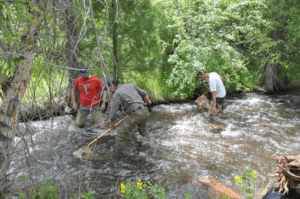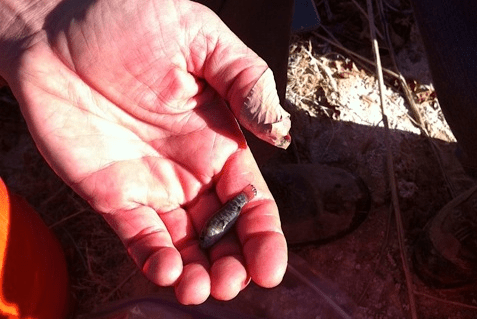
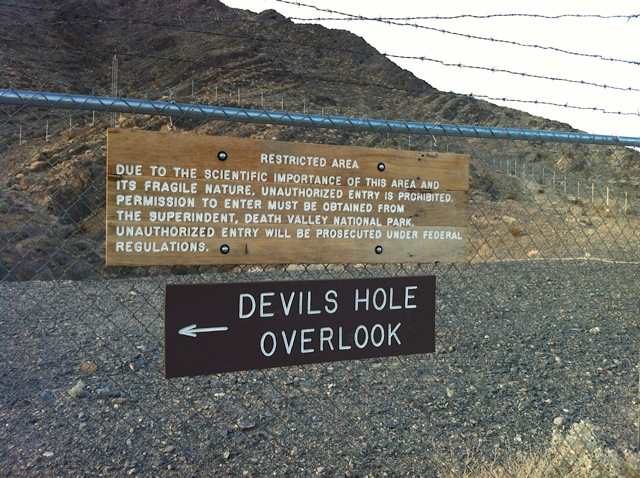
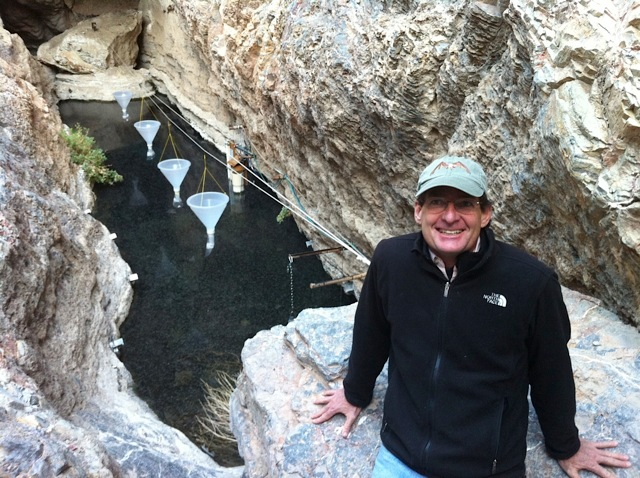
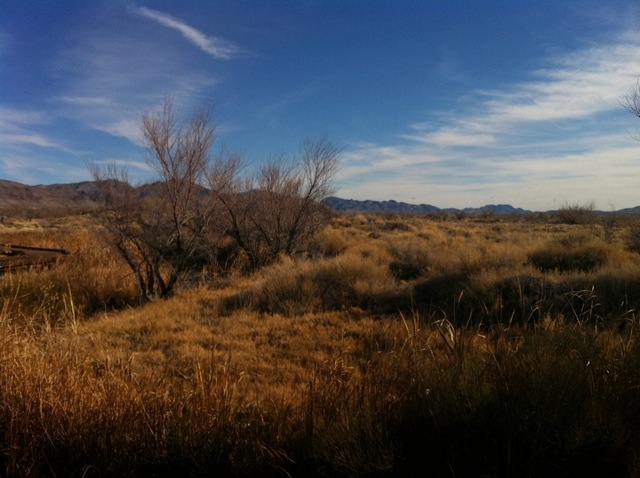
West of Pahrump, Nevada, in a corner of the Mojave Desert a couple thousand feet above Death Valley, a warm aquifer provides a home for one of the world’s rarest animals. It’s a tiny silvery-blue fish, smaller than your pinkie toe, and in the past 50 years it has survived real-estate speculators, death threats, congressional battles, and human screwups. The Devils Hole pupfish—Cyprinodon diabolis—is nothing if not tenacious.
But the biggest existential threat to the pupfish comes from its own DNA. Once upon a time, pupfish lived in a sprawling lake. Some 20,000 years ago, water levels dropped, the landscape turned to desert, and the pupfish ended up in disconnected ponds. Today, nine different species are scattered across the Southwest and half of them are endangered. Devils Hole is the worst case; as of September 2012, there were 75 fish left. Thousands of years of adaptation have left the Devils Hole pupfish able to live only in one very particular environment. It needs 90-degree water, low oxygen, and a shallow submerged ledge on which to spawn. It’s hard enough being endangered. Being endangered and picky is a deadly combination.
Endangered, picky, and unlucky? Even worse. Beginning in the 1970s, government scientists built three pools to contain backup populations of Devils Hole pupfish as a final hedge against extinction. At two of these refuges, pumps, valves, and other mechanical bits malfunctioned repeatedly, killing most of the fish. In one case, lightning struck a transformer. But at the third site, called Point of Rocks, something more interesting happened. Somehow a few pupfish of a different species managed to infiltrate the refuge and—to put it politely—their DNA quickly spread through the population. After about half a decade, every fish in the pool was descended from the invaders, who gave their offspring telltale genes and an extra set of fins. Wildlife officials moved all the hybrids to a hatchery, where, unlike captive Devils Hole pupfish, they couldn’t stop making babies. “There were floor-to-ceiling tanks of these hybrid fish,” says Andy Martin, an evolutionary biologist at the University of Colorado at Boulder who led the research into the hybrids’ DNA. “This was a population that had been sputtering away, and now it was going like mad.”
To Martin, the fact that an influx of new genes caused a population explosion suggested what was wrong: “genetic load,” a glut of defective DNA that accumulates in a small population. On the upside, that diagnosis suggests a cure—a way to save the species. Martin has a plan to bring the fish back from the brink. But to the kind of people who have battled extinctions in the past, his solution is heresy.
For half a century, conservationists have seen themselves as preservationists: Protect species X as it exists in place Y at time Z. Of course, nature has no such compunctions. Evolution is change. So the way to save the Devils Hole pupfish, Martin says, is to introduce genes from its cousin, the Ash Meadows Amargosa pupfish—C. nevadensis, the same little Casanova from the refuge—which is native to a spring just a few miles away. Martin wants to take one or two and drop them in with their endangered relatives. That simple act would have profound implications. It would protect the Devils Hole pupfish by rewriting its genome.
Whether or not you care about pupfish, this plan represents a major philosophical change in how we think about our relationship with nature—because it doesn’t end with the pupfish. It ends with us becoming architects, engineers, and contractors for entire ecosystems. The old approach involved fencing off swaths of wilderness and stepping aside. In the new order, we’d be the stewards not just of land or wildlife but of individual chromosomes. So far, in the world of Devils Hole pupfish conservation, Martin has run into a wall of no. But around the world, in other places where other species are in trouble, the answer, increasingly, is yes.
In 1995, Florida wildlife officials flew eight female cougars (Puma concolor stanleyana) from Texas to breed with their hometown Florida panthers (Puma concolor coryi), a local variety on the brink of extinction. The panther project met with passionate resistance, but it worked. Population numbers have tripled since then. (Of course, their habitat is increasingly covered in asphalt, and the cats often meet their end in a splattery heap on the highway. But at least their genes are hardy and the male cats’ testicles are more likely to fully descend.)
Still, the Florida panther project isn’t exactly like what Martin proposes to do with pupfish. The pumas were two different subspecies. Martin wants to cross two separate species. That’s supposed to be a no-no. In fact, by one definition of what constitutes a species, it shouldn’t even be possible. Scientists have long thought of species as reproductively isolated units. In the days before Darwin, if two animals couldn’t produce fertile offspring, it meant they were different species. Then things got complicated. In the late 1800s, Darwin and naturalist Alfred Russel Wallace, who independently proposed the idea of natural selection, both said the sterile-offspring definition wasn’t enough. Over the next century, evolutionary biologists from Theodosius Dobzhansky to Ernst Mayr ladled on new criteria. Mate choice, physiology, geography, invisible genetic differences—all these might distinguish species.
But it turns out that biology doesn’t even adhere to those categories. For example, the ability to reproduce can evolve far more slowly than other traits. So when one species branches off from another, it may still be able to breed with its relatives up the evolutionary tree. “It raises the question, what really is a species? It’s very hard to clearly articulate,” says M. Sanjayan, lead scientist for the Nature Conservancy. “There are lots of things that can breed together but look morphologically and genetically different.”
That means scientists triaging endangered species might have more options than they thought. Three decades ago, ornithologists made a last-ditch effort to save the dusky seaside sparrow by breeding it with a related bird. (They failed; the last one died at Walt Disney World Resort on June 17, 1987.) Or take rhinos: Sanjayan is part of an initiative to save the northern white rhinoceros—the last eight until recently lived in zoos. The hope is to breed it with the more abundant southern white rhinoceros, which, depending on whom you believe, is either a different species or a different subspecies. It’s anyone’s guess whether the northerners and southerners will choose to mate.
In fact, what counts as a species changes all the time. Recently, DNA extracted from African elephant blood revealed that the animals are actually two distinct species, one living in the forest and one on the savannah. From the outside they’re all but indistinguishable, but genetically they’re deeply divergent—as far apart as a lion and a tiger, or a human and a chimp. A few years ago, Martin’s lab showed that an endangered variety of cutthroat trout had been misidentified, throwing two decades of conservation efforts into confusion. Martin prefers to treat the species concept as a hypothesis, a way to make predictions. But that mode of thinking doesn’t jibe with the legal framework for preventing extinction, which revolves around the existence of clearly delineated species.
The taxonomists who initially described the desert pupfish and sorted them into distinct species counted things they could see: scales, for instance, and the bones in fins. That’s how Linnaeus, the great 18th-century grouper-of-things-with-other-things, did it. “That was the tradition in species designations, that if it looks different enough you’re going to call it a separate species. So then you write this thing up,” Martin says, “and everybody starts to accept it.”
But physiological differences can have more to do with environment than with genetics. In Devils Hole, the geothermally heated water puts the fish’s metabolism into overdrive—or as Martin puts it, “they’re basically starving all the time. And if you compare a starving person to a well-fed person, you might actually think they’re different species if you based it just on shape.” To prove that point, biologists at UC Davis took some C. nevadensis fish from Amargosa Valley and starved them at high temperatures to replicate the environment of Devils Hole. The fish soon began to look like their Devils Hole cousins. Martin’s own research shows that the Devils Hole and Ash Meadows Amargosa pupfish are more similar genetically than many other organisms categorized as a single species. They’re more similar than a human being from Kenya and one from, say, Scandinavia. (Biologists love to fight about taxonomy—otherwise you could redesignate both pupfish as the same species and let the piscine sexytime commence.)
One morning, Martin takes me to a spring-fed aquamarine lagoon in the Mojave, where dozens of Ash Meadows Amargosa pupfish shimmer bright blue in the desert sunshine. These fish are doing just fine. “These guys over here,” Martin says, “are genetically different than the ones in that spring over there. But does that mean that they’re different species? Probably not.”
Jurisdictionally part of Death Valley National Park, Devils Hole sits amid 23,000 acres of nature preserve. But in the 1960s, agriculture tapped the aquifer under the Mojave, dropping the water level in Devils Hole. The pupfish’s spawning ledge began to jut above the surface like a fat man’s gut in a draining bathtub. The fish went on the federal endangered-species list and, after nine years of court battles, became the first nonhuman animal to be awarded legal water rights. Two decades ago, annual April fish counts (overseen by the ominously named pupfish Incident Command Team) routinely turned up more than 200 fish. September counts, always higher, often yielded 500. But in the mid-1990s, the numbers started to slip. Then in 2004, a group of researchers trying to make sense of the slump left a few fish traps on the rocks just above the pool. A flash flood sent water cascading through the desert and into the cavern, knocking the traps into the aquifer. Curious pupfish ventured close, and more than a third of the fish in the pool perished.
During the spring count in 2006, divers found only 38 survivors. “The fish looked emaciated, really malnourished,” says Kevin Wilson, the aquatic ecologist for Death Valley National Park who oversees Devils Hole. “The edges of their fins were kind of deteriorating. So the U.S. Park Service started a supplemental feeding program.” Well fed, the fish seemed to perk up. During spawning season the next spring, biologists noted an increase in larvae. “So we were like, ‘Oh, we’ve figured out the problem. It’s food!’” Wilson recalls. “We thought in the fall we’d have all these adults.” But most of the young fish didn’t survive, and the population has yet to rise above 133.
Martin thinks it’s too late to worry about external factors like food. He believes the Devils Hole pupfish may be experiencing a “mutational meltdown,” a feedback loop of genetic decline. More and more mutations are spreading through a shrinking population, without a way for natural selection to weed them out. It’s an extinction vortex.
Nature creates hybrids. There’s the pizzly bear, a cross between a grizzly and a polar bear. There’s the mix of a common American crocodile and an endangered Cuban one. There are Galapagos tortoises that harbor DNA from a giant cousin made famous by Darwin and presumed extinct since the mid-1800s. And there’s you: You are, most likely, part Neanderthal.
But when an endangered species starts to really nose-dive, nature sometimes doesn’t move fast enough. One possible solution is to engineer hybrids. “Automatically saying, ‘Hybridization is bad and we’re never going to do it’—that’s a bad rule,” says Alan Templeton, a biologist at Washington University in St. Louis. “You need to get rid of these rules and deal with the particulars of each situation.”
Templeton knows what he’s talking about. In the 1980s, he set out to save the Eastern collared lizard—a spotted, iguana-like creature that runs on its hind legs—which had mostly disappeared from its native Ozarks. A decades-long policy of suppressing wildfires had changed the landscape. The spiny critters Templeton gathered from various Missouri glades were officially all the same species, though their populations had become so scant and segregated that their gene pools had diverged.
Templeton’s goal was to summon back the diversity that would insulate the lizards from calamity. He also instituted controlled burns of the forest. Thirty years on, the lizards are thriving. “Yeah, we were restoring a species,” Templeton says, “but we were really restoring the glades and fens of the Ozarks.”
Still, because Templeton’s lizards were one species, he didn’t have to face a bigger question: When you dilute a gene pool to rescue it from oblivion, what exactly are you saving? Some biologists describe this issue as one of “genetic integrity.” Maybe it’s not enough to save some of the unique DNA that might otherwise have died out. Or maybe it’s too much. This worry has plagued conservation for decades: Is the idea of “pure” or “pristine” nature even a useful conceptual tool? Conservationists face what is in some ways as existential a threat as the one confronting the pupfish. The more they learn about nature, the more they wonder which part they’re supposed to conserve.
Last summer at the Aspen Environment Forum, E. O. Wilson—arguably the world’s best-known conservation biologist—said that for human beings to maintain a viable environment on Earth, we should set aside half the planet’s surface for wild nature. But Emma Marris, a science writer and author of Rambunctious Garden, about human intervention in nature (and, full disclosure, a friend of mine), pushed back. Everything is already touched by human hands, she said. We have to manage it.
Wilson was aghast. “Where do you plant the white flag you’re carrying?” he asked.
Marris turned to a quote from ecologist Joe Mascaro: “I never took up arms,” she said. In fact, Marris and her husband, philosopher Yasha Rohwer, have found that more than 100 scientific papers treat the preservation of genetic integrity as some kind of manifestly obvious duty. But, they wrote, it ain’t necessarily so. Martin’s alternative: “genetic restoration,” in which organisms are given a fighting chance with new DNA. “Integrity” is irrelevant.
The future, then, will involve more intensive management of ecosystems and their inhabitants. That includes meddling not just in biogeography—what lives where—but in genes. There’s a delicate balance between saving a species and saving a gene pool, and calibrating it may be one of the biggest challenges of 21st-century conservation. We might, for instance, simply let the Devils Hole pupfish slip away and fill its pool with something else. Scientists like that idea about as much as they like creationism. They believe that any critter might play a crucial, irreplaceable role in an ecosystem. “You need to do genetic restoration just as much as you need to do habitat restoration,” Martin says, back at his office in Boulder, Colorado, where his MacBook sits near a terrarium holding two pet snakes. He wears a long-sleeved T-shirt bearing the slogan think outside the box. “But this is a flagship species,” he says, “one of the first ever listed as endangered. And the feeling is that genetic restoration is admitting defeat.”
From a caged overlook, visitors to Devils Hole gaze down on the rectangular pool 50 feet below and imagine the minnowlike fish swimming within. But I get a tour. Wilson, the Park Service ecologist, unlocks two gates and leads Martin and me down a steep metal staircase into the cavern. Wilson agreed to let us in only if we brought clean shoes, to avoid contaminating the place with nonnative species.
It is midafternoon, but down in the limestone crack it feels like dusk. The hole itself is a series of collapsed caves along a fracture in the rock, and the depth of the aquifer below it has never been determined. Divers have descended nearly 500 feet without hitting the bottom; two never returned, an abandoned flashlight on a rock ledge their only trace. Though the nearest ocean is 250 miles away, the aquifer is so big it has its own tides.
Funnels strung above the water’s surface measure how much carbon (bugs, pebbles) falls into the pool. PVC pipes, set up beside an automatic feeder, monitor the water level. No one is studying the fish directly. There aren’t enough of them. The risk of losing even one is too great.
Squatting on a boulder, Martin peers into the water. “I love this place,” he says. An opaque film of calcium carbonate obscures the surface. Wilson, who had earlier told me he was still pretty optimistic about the pupfish’s ability to survive this latest population crash, asks to hear Martin’s hypothesis about why they’re dying.
Martin launches in. The fish are suffering from “a high load of deleterious mutations” that seem to hit early in development, when there are fewer cells and so more opportunity for slightly sketchy genes to have an outsize impact. “The worry I have,” Martin says, “is that no matter what you do, you’ll never get rid of those alleles, so the fish will always have super-low survivorship.”
That doesn’t mean Martin thinks they’re unequivocally doomed. Not far from the cavern, the Fish and Wildlife Service is finishing a $4.5 million high tech refuge for Devils Hole pupfish. It’s the place where Martin could try genetic rescue. Legally, until the natural population rises, no fish can be evacuated to the refuge’s 100,000-gallon cement tank. (Shrinking their numbers again could lead to another genetic bottleneck.) But it seems unlikely, after all the pupfish’s struggles, that anyone would stand by while they dwindled to nothing. Either the efforts in the cavern will succeed, numbers will rise, and some fish will be moved to the refuge, or numbers will fall even more and government officials will take some other 11th-hour action.
If the pupfish numbers crash again, I ask Wilson, would he ever consider hybridizing the fish to save them?
Impasse. “It wouldn’t be the same species,” he says.
We climb out of the cave, and Wilson padlocks the gate behind us. From the road, we see the new pupfish refuge facility, nearly finished, one of the only buildings for miles. There, Martin might be allowed to drop just two Ash Meadows Amargosa pupfish into an artificial pool and see what happens. “It’s no longer just a biological question,” Martin says. “It’s an ethical, philosophical question. Because the fish won’t care.”


